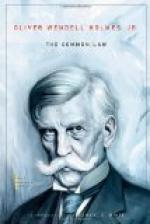I now turn from the German to the Roman sources. These have the closest connection with the argument, because much of the doctrine to be found there has been transplanted unchanged into modern law.
The early Roman law only recognized as relatives those who would have been members of the same patriarchal family, and under the same patriarchal authority, had the common ancestor survived. As wives passed into the families of their husbands, and lost all connection with that in which they were born, relationship through females was altogether excluded. The heir was one who traced his relationship to the deceased through males alone. With the advance of civilization this rule was changed. The praetor gave the benefits of the inheritance to the blood relations, although they were not heirs, and could [361] not be admitted to the succession according to the ancient law. 1 But the change was not brought about by repealing the old law, which still subsisted under the name of the jus civile. The new principle was accommodated to the old forms by a fiction. The blood relation could sue on the fiction that he was an heir, although he was not one in fact. 2
One the early forms of instituting an heir was a sale of the familia or headship of the family to the intended heir, with all its rights and duties. 3 This sale of the universitas was afterwards extended beyond the case of inheritance to that of bankruptcy, when it was desired to put the bankrupt’s property into the hands of a trustee for distribution. This trustee also could make use of the fiction, and sue as if he had been the bankrupt’s heir. 4 We are told by one of the great jurisconsults that in general universal successors stand in the place of heirs. 5
The Roman heir, with one or two exceptions, was always a universal successor; and the fiction of heirship, as such, could hardly be used with propriety except to enlarge the sphere of universal successions. So far as it extended, however, all the consequences attached to the original fiction of identity between heir and ancestor followed as of course.




